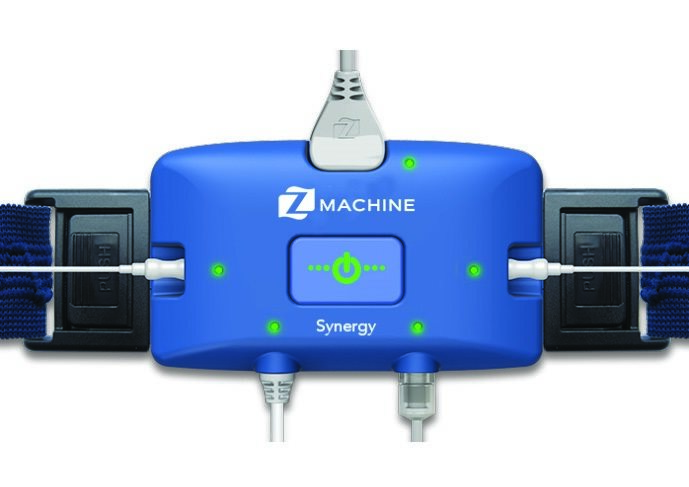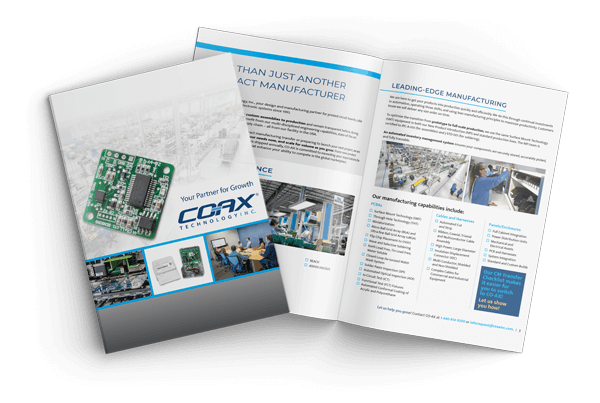Medical Electronics Contract Manufacturing
Medical Device Contract Manufacturing
In the strictly regulated medical device manufacturing field, you need an experienced partner with the quality management system, regulatory certifications, and knowledge of process validation necessary to fast-track your products to market.
Beyond our Quality Management System being certified to ISO 13485 and FDA registration, CO-AX is a trusted supplier to deliver assemblies and finished products worldwide.
Highly Efficient PCBAs, Final Assembly and Production of Medical Devices
We help you move from prototype to assembly to full production using a dedicated NPI line, multiple SMT lines, and the final assembly of integrated enclosures.
Every step in our process is controlled, reportable, and traceable. We proactively manage the supply chain using SiliconExpert and our proprietary tracking software.
The Supply Chain, Engineering, and Materials Teams at CO-AX work together to ensure we meet our customers’ delivery schedules. During these challenging times of parts shortages, we offer the agility and flexibility to help you Design for Availability – getting you to market as planned.
Talk to a medical device manufacturing expert
Customer Success Stories

This customer makes sleep apnea monitors for provider-managed at-home use, so the unit must be full-featured, durable, easy to use, and aesthetically pleasing.
CO-AX manufactures the PCBA for this Class II medical device and integrates all components into the final enclosure. We completed the Process Validation using pFMEA, IQ, OQ, and PQ and created the assembly work instructions.
Responding to the pandemic, we worked closely with the customer to prototype first articles then scale for full production.
The Critical Importance of Traceability for Medical Device Manufacturers
Medical device and component traceability is a mandatory exercise dictated by today’s regulatory environment. In the United States, the Food and Drug Administration (FDA) mandates stringent traceability regulations for medical devices to establish standards for safety and efficacy, requiring detailed tracking of devices from manufacturing through distribution.
In addition to meeting regulatory standards, traceability offers companies numerous benefits related to patient safety, risk mitigation, and product quality, to name a few. Traceability can identify and then isolate defective devices, facilitating the tracking of recalled items. These product recalls protect patients from inaccurate data stemming from faulty devices. Traceability also helps prevent the use of any medical devices approaching or past the expiration date to safeguard patient care.
Medical device manufacturers can minimize risk by using traceability to monitor the supply chain. Traceability best practices enable companies to monitor supply chain disruptions and swiftly address any potential issues to help maintain production schedules and desired product quality. A quick response allows companies to anticipate and track expenditures, maintaining control over costs to realize a greater profit potential.
The medical device market benefits from working with a contract manufacturer with a thoroughly integrated parts traceability program as part of its quality management system. This integration can:
- Bolster quality oversight
- Guarantee material reliability
- Ensure adherence to regulatory standards during production
A properly aligned and instituted quality management system will facilitate rapid problem detection, foster more immediate remedial measures, and generate the detailed documentation necessary for regulatory compliance.
CO-AX leverages the Aegis FactoryLogix software to fulfill the rigorous requirements of medical device traceability. This system helps provide medical device manufacturers with the security and knowledge that all CO-AX products are in complete alignment with regulatory expectations set forth by the US FDA.
What is part traceability for medical PCB/PCBA manufacturing, and what are its benefits?
Part traceability is crucial in medical PCB/PCBA manufacturing, providing documentation or supplying the original location for every component, its place of manufacture, and its use. A key aspect of traceability is material assurance. Parts traceability can help pinpoint circumstances associated with any product defects, enabling swift corrective measures that mitigate risks and enhance quality control. It helps medical device manufacturers comply with regulatory requirements. Companies can also demonstrate their commitment to safety and reliability to the end user.
Why did CO-AX select FactoryLogix Software to help with parts traceability?
FactoryLogix by Aegis Software is a state-of-the-art MES (manufacturing execution systems) platform tailored for the dynamic needs of electronics manufacturing, including medical PCBs and PCBAs. Its integrated approach to managing the manufacturing lifecycle enhances efficiency, improves product quality, and ensures compliance with industry standards by providing real-time insights and control over the production process. This type of software optimizes shop floor automation and will help usher in Industry 4.0.
How do these programs relate to the Device History Record?
Device History Records (DHR) are a fundamental component of the quality management system in industries that manufacture medical devices, electronics, and similar product segments. The DHR is a compilation of records describing a finished device’s production history. It supplies evidence that the device was manufactured according to the pre-established design and production plan, as detailed in the Device Master Record (DMR). The DHR integrates with MES software to manage and monitor work in progress on the factory floor, including materials management, scheduling, data collection, and analysis.
Working in concert with MES software, a DHR helps maintain the integrity and traceability of medical devices. In tandem, the two enable a seamless flow of information, enhanced traceability, improved production control, and the ability to respond to quality issues or regulatory inquiries swiftly.
How Are Medical Devices Manufactured?
The manufacturing process for medical devices involves a series of steps to design, produce, and test devices used in medical and healthcare applications. The process is highly regulated and requires adherence to strict quality and safety standards to ensure the devices are safe and effective for patients. While the specifics may vary depending on the type of medical device and the company’s manufacturing practices, the general steps involved in the manufacturing process are as follows:
The design phase produces a detailed blueprint of the device, including PCBAs, power supplies, sensors, and other components required to perform to specifications. All stages and changes must be documented in detail.
Prototyping and design for manufacturing (DFM) come next. This step ensures the device can be assembled effectively and for long-term production. Documented sign-off to move from prototyping/NPI to production is critical based on clinical trials performance.
Moving to production, PCBAs, cables, and other components are assembled and tested for functionality and quality. The design and bill of materials must be frozen at this stage in order to meet regulatory standards. Frequently companies will contract with an electronics manufacturing service provider for this phase of medical device manufacturing. CO-AX Technology utilizes IC miniaturization, micro ball grid array (BGA), and ultra-fine ball grid array (uBGA) for medical device fabrication.
In certain Class I and II medical devices, a turnkey box build is the next step in the manufacturing process. A box build integrates the various components and subassemblies into an enclosure for distribution to the market. In some cases, that “box” could be the final device, such as a home health monitoring device.
Most non-commodity Class I and II medical devices are manufactured in the United States under strict regulatory guidelines. Onshore medical device electronics manufacturers should have an ISO 13485-certified Quality Management System, FDA registration, and full traceability to comply. Read our blog, How to Choose a Medical Device Contract Manufacturer, for important insights into selecting the right partner to get your device to market.



